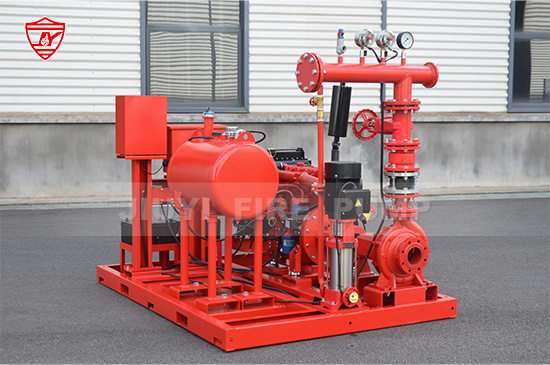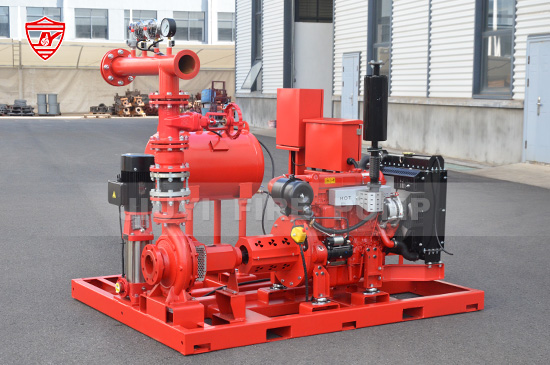In any fire protection system, the fire pump is the heart of reliable water delivery. For it to perform effectively during an emergency, maintaining airtight suction lines is critical. Even minor air leaks in the suction line can drastically affect pump performance, cause cavitation, reduce discharge pressure, or even prevent the pump from priming properly.
This article will explore the causes, signs, testing methods, and best practices to prevent air leaks in fire pump suction lines — ensuring your fire protection system operates at peak reliability when needed most.

A fire pump’s suction line is responsible for bringing water from the water source — whether a tank, reservoir, or underground main — into the pump. The suction line must be completely airtight so that the pump can maintain the necessary vacuum pressure to draw water efficiently.
If air enters the suction line, the pump may lose its prime or develop vapor pockets, leading to cavitation — a damaging condition that can erode impellers, reduce flow, and shorten the pump’s lifespan.
NFPA 20, the standard for the installation of stationary fire pumps, emphasizes that suction piping must be designed and installed to minimize air leaks and friction losses.
Air leaks can occur for many reasons, often due to installation errors, poor maintenance, or material wear over time. Here are the most common causes:
Loose Flange Bolts or Gaskets
Improperly tightened flange bolts or deteriorated gaskets are the most frequent sources of suction leaks. Over time, vibration or temperature fluctuations can loosen joints.
Cracked or Corroded Piping
Older suction pipes may develop cracks or pinholes from corrosion, particularly when systems use untreated water sources.
Leaky Suction Fittings and Valves
Foot valves, check valves, and threaded fittings can be potential leak points if their seals are worn or improperly installed.
Improper Pipe Alignment
Misalignment between the suction pipe and the pump suction flange can create stress points that eventually lead to air ingress.
Nonmetallic Piping Expansion
In systems using PVC or composite suction lines, thermal expansion and contraction can loosen joints over time, allowing air to enter.
Faulty Priming Connections or Vacuum Lines
Priming devices and air-release lines can themselves be sources of leakage if fittings are not sealed properly.
Detecting air leaks early is essential to avoid performance failure during fire conditions. Some of the most telling signs include:
Fluctuating suction or discharge pressure readings
Unusual pump noise or vibration (especially during priming)
Reduced flow rate and discharge pressure
Pump losing prime after shutdown
Visible air bubbles in the suction gauge or test line
Difficulty in achieving stable pressure during testing
If your fire pump exhibits any of these symptoms, an air leak should be one of the first conditions to investigate.
There are several reliable ways to identify where air might be entering your fire pump suction system:
Vacuum Test
Shut off the discharge valve and vent the air from the pump casing.
Use a vacuum gauge to measure the drop in vacuum pressure over five minutes.
According to NFPA 20, the loss should not exceed 10 inches of mercury in five minutes. Greater losses indicate a potential air leak.
Soapy Water Method
Apply a soap solution to joints and flanges while under slight vacuum. If bubbles appear, the joint is leaking.
Pressure Decay Test
Seal the suction piping and pressurize it slightly with air. Observe for any pressure drops over time.
Acoustic Leak Detection
In large installations, ultrasonic detectors can help pinpoint the exact leak location by sensing high-frequency sounds from escaping air.
Visual Inspection
Look for corrosion, gasket displacement, or visible damage around joints, valves, and fittings.
Preventing air leaks starts with proper design, installation, and maintenance. Below are the most effective preventive measures:
Ensure suction piping meets NFPA 20 requirements, including:
A straight, unobstructed pipe run into the suction flange (minimum 10 pipe diameters in length if possible).
Correct pipe sizing to maintain velocity under 15 ft/s (4.6 m/s).
Use of eccentric reducers installed flat on top to prevent air pockets.
Use gaskets made of materials compatible with the fluid and temperature conditions. Rubber or neoprene gaskets are suitable for most fire water applications. Always use approved sealants on threaded joints.
Flange faces must be clean, parallel, and evenly tightened in a cross pattern using a calibrated torque wrench. Uneven pressure can warp flanges and cause micro-leaks.
Keep the suction line as short and straight as possible. Elbows, reducers, and unnecessary fittings increase the risk of air traps and turbulence.
Schedule routine maintenance checks on the suction line, paying attention to gasket condition, valve operation, and flange tightness. Inspect for corrosion, especially in areas near the water source.
Always ensure the suction line and pump casing are completely filled with water before starting. Air trapped during startup can lead to loss of prime and cavitation damage.
Vibration isolators between the pump base and piping can prevent joint loosening over time.
Install accurate gauges on both suction and discharge sides. Monitoring pressure trends can reveal gradual air ingress before it becomes critical.
Cavitation is the formation and collapse of vapor bubbles inside a pump when the pressure in the suction line falls below the vapor pressure of water. Air leaks worsen this effect by lowering suction pressure even more.
Signs of cavitation include noise like “gravel” inside the pump, reduced discharge pressure, and vibration. Continuous cavitation can damage impellers and shorten the fire pump’s life.
Preventing air leaks is therefore one of the most effective ways to avoid cavitation and ensure long-term system health.
Use eccentric reducers flat on top — never concentric reducers, as they can trap air.
Position the suction inlet below the water level of the source to maintain a flooded suction condition.
Avoid using flexible hoses on the suction side unless designed for vacuum applications.
Ensure foot valves are airtight and located far enough below the water surface to avoid vortex formation.
Maintain a proper distance from the tank wall or floor — typically twice the pipe diameter — to prevent vortexing and air entrainment.
Periodic fire pump testing — such as weekly churn tests and annual flow tests — provides opportunities to verify suction line integrity. During each test:
Observe suction and discharge pressure behavior.
Listen for abnormal pump sounds.
Inspect for any visible leaks around the suction flange or fittings.
Conduct vacuum tests at least annually to confirm the suction line remains airtight.
Recording these results creates a valuable maintenance history that can help predict potential failures before they occur.

Air leaks in a fire pump suction line may seem like a minor issue, but their impact can be serious — from reduced pump performance to complete failure during an emergency. By following NFPA 20 guidelines, ensuring correct installation, and performing regular inspections and vacuum tests, you can prevent air ingress and guarantee consistent, reliable fire pump operation.
A properly sealed suction line not only protects the pump but also ensures that your fire protection system will deliver full performance when it’s needed most — protecting lives and property.